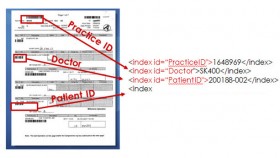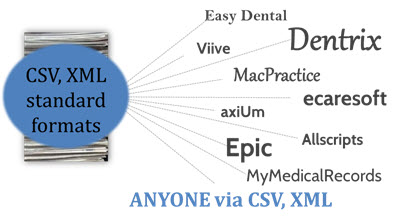 Flexible Options for Medical and Dental Record Indexing
Flexible Options for Medical and Dental Record Indexing
Medical and dental records have many special document processing needs. With the movement to comply with the Health Information Technology for Economic and Clinical Health (HITECH) Act, many companies and health care organizations have implemented sophisticated EHR systems, while others are just beginning. Along the way some of the special needs of processing medical and dental related documents have been highlighted. One such need is what we call scan once, index many.
Used to process EOB's or other records where the same document needs to be in multiple patient records, scan once index many allows the operator to easily scan the EOB once, index the different patients' information via an onscreen keyboard, drag-and-drop OCR, or barcode reading methods, and route to the appropriate patients' records with little to no intervention. ImageRamp accommodates this processing as well as the traditional scan once, split and index used when a single file may consist of multiple patient records which need to be split, named and routed to the correct patient’s records.
Field Validation Improves Accuracy
 Entering the correct data the first time can save countless hours when trying to locate documents later. Field validation improves accuracy. If a patient record ID should contain three alpha characters followed by five numbers, ImageRamp can use Regular Expressions or regex to recognize this pattern and flag records that do not meet this pattern for interactive operator indexing.
Entering the correct data the first time can save countless hours when trying to locate documents later. Field validation improves accuracy. If a patient record ID should contain three alpha characters followed by five numbers, ImageRamp can use Regular Expressions or regex to recognize this pattern and flag records that do not meet this pattern for interactive operator indexing.
So How Can the Index Data be Identified and Extracted?
Individually or in combination, advanced capture technologies can be used to capture the index information with little or no user intervention. You might be familiar with using barcode information as a proven, mature capture method. Newer methods based on OCR mined text can also greatly automate indexing.
Data mining with re gex provides a fast and powerful method to search and extract specific text strings found within documents. Data identified with regex can be used to index documents as well as name the output files, or even create folders. Regex can also play a role in line item extraction. This extension of data mining is common within invoice forms and other table based documents. With line item extraction, instead of extracting strings of text beside a matching pattern, users may want to obtain data found below the match word in a column type fashion.
gex provides a fast and powerful method to search and extract specific text strings found within documents. Data identified with regex can be used to index documents as well as name the output files, or even create folders. Regex can also play a role in line item extraction. This extension of data mining is common within invoice forms and other table based documents. With line item extraction, instead of extracting strings of text beside a matching pattern, users may want to obtain data found below the match word in a column type fashion.
Built on proven standards and a successful history, barcode recognition offers the most trustworthy recognition technology for data capture. Barcodes identify merchandise and equipment, tag documents patients in hospital care, all with accuracy that is unmatched by any other classification approach. Barcodes can be used in both structured and unstructured document formats. Barcode information can easily be extracted and combined with other information from text mining or system data for index purposes.
Integrating Extracted Index Information
Captured index information can be sent via XML or CSV files to a document or content management system such as an EMR/EHR or EDR system. Popular systems such as Epic and Dentrix can accept these files and integrate the information.

Cloud-based Document Processing and Indexing
Simply send an email with attached or referenced files with natural language instructions on what you want done to the files, and the results are returned. No need for local document processing software or complex interfaces, just email and your files. Use with our DocuFiCloud Service or within your own intranet. Use our patent-pending technology from smartphones, tablets, PCs and more to process scanned files on your device or network or PDF print streams.

